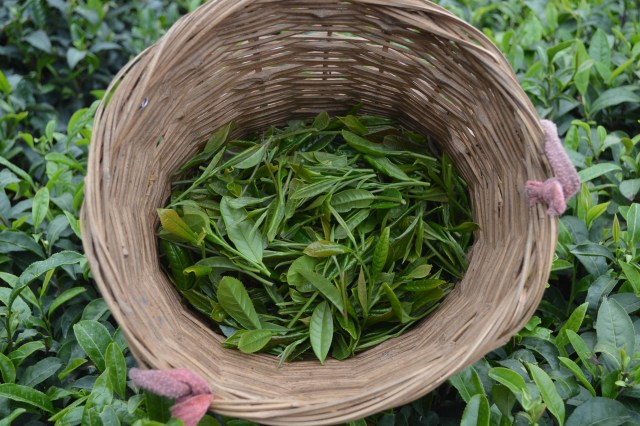Fu Brick 茯砖 [fú zhuān] tea is a very special dark tea, people call it, the mystery tea of ancient Chinese Silk Road. Fu Brick has been made firstly in 1860s, dark tea crude materials were pressed into big bamboo baskets and transported from Hunan province to Shanxi province to make further processes at that time. Fu Brick was also called Hu Tea “湖茶” as it from Hunan province, Fu Tea “伏茶” as the tea process during hottest days- Fu Tian 伏天 in Summer, and Jingyang Brick “泾阳砖” as bricks formed in Jingyang.

Wudang Fu Brick uses fresh tea leaves from Wudang areas of Hubei province as tea materials, harvested in late springs and summers, the productions are very complicated including 28 different steps in total, 6 times fermentations.

Fresh tea leaves are roasted and steamed, rolled, then piled up to 1-3 meter for 3-4 hours, when the piles’ temperatures reach 75-88℃, piles should be stirred to cool down gradually and evenly. This procedure is called Ou Dui “沤堆” pile-fermentation, the first fermentation. It is different from Wo Dui “渥堆” pile-fermentation of Shu Pu’er tea, Ou Dui uses the juice from tea leaves self to ferment, Wo Dui otherwise use extra water to ferment.

This whole fermentation is mainly about to change tea color from green to black, after Ou Dui, when the water contents reach the standard, tea leaves are dried naturally by sun, so called Shai Qing 晒青 – sun dried. After a few hours, tea color could change very dramatically, which of course depends a lot on weather. In order to dry completely, in the meantime, tea leaves need to be stirred from time to time, to make every piece of tea leaf to have a nice and smooth dark color.



The second fermentation is called, cold fermentation, this procedure costs at least 12 months, the humidity and temperature should be controlled.




After cold fermentation, loose tea materials need to be sterilized and disinfected by a high temperature steam, blended with other loose tea from different grades on demands, pile-fermented, then weighed, steamed, and pressed into forms according to preferences. For example, loose tea leaves are made into brick-like forms, bricks sould look smooth, clean-cut and with the same thickness and firmness. When the temperature of the forms drop to around 50℃, tea bricks could be taken out from forms and put into constant-temperature chambers.



In constant-temperature chambers, the temperature should be kept at 28℃ and the relative humidity 80%, which can help tea bricks to produce golden flower 金花- Eurotium Cristatum in 12-15 days, this process is called Fahua 发花 [fā huā]. In order to germinate granules well, many conditions need to meet, for example, the tightness of bricks, there should be enough space left inside bricks for activities of microbes.

Lastly, chamber temperature can be turned gradually up to 45℃ to dry tea bricks completely, after 5-7 days, bricks could be taken out and wrapped with paper immediately. The last fermentation happens in the customers’ hands, a proper storing could help to improve textures and flavours.

Denser and larger granules with the bright golden color are considered to be better, tea soup color should be bright yellow/orange to dark red with pure fragrance and mellow flavour, rich golden flower aroma.
Wudang Fu bricks have many different flovours mainly depending on tea materials, fermented degrees, aged years and etc..


